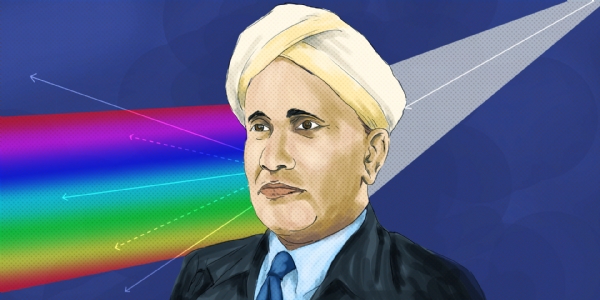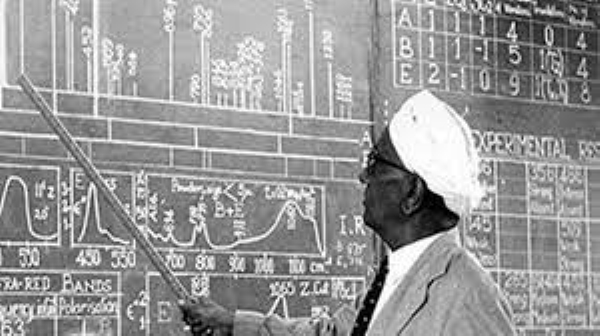CV Raman- The Man Who Explain Why Sea & Sky Appears Blue
Total Views |
"Science is a fusion of man's aesthetic and intellectual functions devoted to the representations of nature. It is, therefore, the highest form of creative art"- CV Raman
For a second, can you just imagine life without science? Isn't it hard? Without science, we can't spend even a minute, microseconds of our life, can we. No one on this planet can imagine its existence without science. Whether you believe it or not, we can't simply live without science. That's the only reason we believe in 'Science for all and all for science'.

And today is 'the day' when we celebrate National Science Day, to widely spread the message about the importance of science in the daily lives of people. For those who don't know, India celebrates National Science Day every year on 28th February (since 1987) to commemorate the discovery of the phenomenon of scattering of photons which was later known as the ‘Raman Effect'. CV Raman announced the discovery of the 'Raman Effect' in 1928 while working in the laboratory of the Indian Association for the Cultivation of Science, Kolkata. He was awarded the Nobel Prize two years later. He was awarded the Bharat Ratna in 1954.
His novel discovery was the change in wavelength of scattered light on encountering a transparent chemical compound. Raman was also the first Indian to get Nobel Prize in science along with that he stood as the first non-white person to be the Nobel laureate. It took him merely Rs.200 to make this discovery. He was the one who gave us the scientific explanation, why the sea & sky appears to be blue. The reason for this phenomenon lies in the scattering of the sunlight by the molecules of the water. Raman had shown that the blue color of the sea is not because of the reflection and absorption of the sky individually but it is due to the molecular diffraction.
Chandrasekhara Venkata Raman, was born at Tiruchirappalli in Tamil Bramhin family on November 7th, 1888. His father was a lecturer of Mathematics and Physics, who influenced Raman to follow the course of Science. At the age of 15 he had a degree with a gold medal in physics. By the time he was 19, he had MA.

After completing his studies, he appeared for the Financial Civil Services (FCS) examination, because of his father's wish. In 1907, he went to Kolkata and joined as Assistant Accountant General. Soon he quit his government service, and joined the University of kolkata in 1917, as the first Palit Professor of Physics. After 15 years at kolkata, he became the Professor at the Indian Institute of Science at Bangalore from 1933-1948 and since 1948, he became the Director of the Raman Institute of Research at Bangalore which was established and endowed by him.
While he was teaching at the University of kolkata, Raman continued his research at the Indian Association for the Cultivation of Science (IACS) in kolkata. He later became an honorary scholar at the association. The impetus for his research on this phenomenon came while he was on his way to England on the ship in 1921 for a conference, his first voyage outside the country.
The Raman Effect is a change of wavelength established by some of the radiations scattered in the medium. The effect is specific to the molecules which cause it and so can be used in spectroscopic analysis. The Raman Effect forms the basis for Raman Spectroscopy which is used by chemists and Physicists to gain information about materials.
Raman Effect, change in the wavelength of light that occurs when a light beam is deflected by molecules. When a beam of light traverses a dust-free, transparent sample of a chemical compound, a small fraction of the light emerges in directions other than that of the incident (incoming) beam. Most of this scattered light is of unchanged wavelength. A small part, however, has wavelengths different from that of the incident light; its presence is a result of the Raman Effect.
Some interesting facts:
Incidentally, the Russians don't like Raman much. Yes, you heard it right! Russian scientist Grigory Samuilovich Landsberg together with Leonid Mandelstam discovered inelastic combinatorial scattering of light, Raman Effect (Feb 21) a week before Raman (Feb 28). However, the phenomenon became the Raman effect because Raman published his results earlier than Landsberg and Mandelstam, Russians still don't use the phrase 'Raman Effect'. They call it Combinatorial Scattering.
Dr. Ernest Rutherford, the man who discovered the nucleus and the proton, referred to Raman's spectroscopy in his presidential address to the Royal Society in 1929. Raman was acknowledged by society and he was also presented with a knighthood.
Raman was not only an expert on light, he also experimented with acoustics. Raman was the first person to investigate the harmonic nature of the sound of Indian drums such as tabla and mridangamRaman.He explained in detail how these musical instruments produce harmonious tones and notes.
.
.
.
.